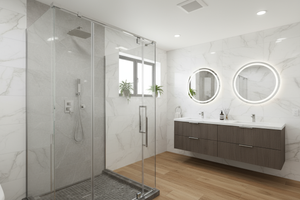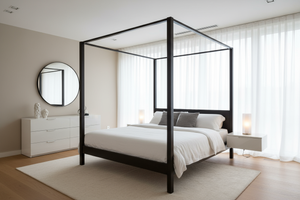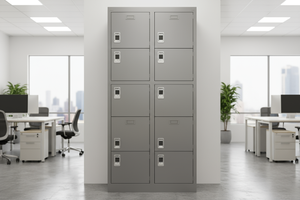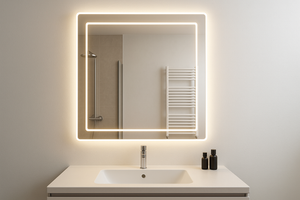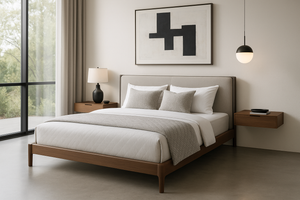Choosing the Right Pull-Up Bar for Your Home Gym A Comprehensive Guide

Building a home gym is a great step towards a healthier lifestyle. A key piece of equipment to consider is a pull-up bar for home gym use.
Pull-up bars are versatile and compact. They offer a range of exercises for upper body strength and muscle development.
However, choosing the right pull-up bar can be challenging. There are various types to consider, each with its own pros and cons.
Factors such as space, budget, and your fitness goals play a crucial role. You also need to consider installation, weight capacity, and the types of exercises you plan to perform.
This comprehensive guide aims to simplify the selection process. It will help you make an informed decision that aligns with your needs and preferences.
So, whether you're a fitness enthusiast or just starting your home workout journey, let's dive in and find the perfect pull-up bar for your home gym.
Ready to build a complete home gym? Pair your pull-up bar with our full range of gym stations and gym weights to create a powerful, space-efficient workout setup.
Understanding the Importance of a Pull-Up Bar in Your Home Gym
A pull-up bar is invaluable for any home gym. It's an essential tool for building upper body strength and enhancing overall fitness.
Pull-up bars target multiple muscle groups. Using one can effectively engage your back, shoulders, arms, and core during workouts.
Beyond standard pull-ups, a pull-up bar offers exercise versatility. You can perform chin-ups, leg raises, and advanced moves like muscle-ups.
Here’s why a pull-up bar is a smart choice for home workout equipment:
- Versatility: Supports a wide range of exercises.
- Space Efficiency: Requires minimal space and can fit in various settings.
- Cost-Effectiveness: Cheaper than many gym memberships or other equipment.
Additionally, having a pull-up bar at home means convenience. It encourages regular exercise, eliminating the need to travel to a gym.
By incorporating a pull-up station into your routine, you can steadily improve muscle tone and functional strength. Embracing this tool contributes significantly to balanced workouts and achieving your fitness goals.
Explore our full range of options in the Pull-Up Bars & Stations collection to find the perfect fit for your training style and space
Types of Pull-Up Bars: Pros and Cons
Choosing the right pull-up bar involves understanding various types and their pros and cons. Each type serves different needs and preferences.
It's crucial to evaluate factors like space, installation requirements, and the types of exercises you plan to perform. This ensures the pull-up bar aligns with your fitness goals and home setup.
Here's a quick overview of the common types of pull-up bars:
- Doorway Pull-Up Bars: Easy installation, but may damage door frames.
- Wall-Mounted and Ceiling-Mounted Bars: Stable and permanent, but require drilling.
- Free-Standing Pull-Up Stations: Versatile, but need more space.
- Portable Pull-Up Bars: Highly mobile, but less stable.
Each type of pull-up bar has unique features and limitations. Understanding these can help you make an informed decision that best suits your fitness journey.
Investing in a pull-up bar that fits well with your lifestyle can significantly impact your workout routine. It's important to weigh the pros and cons to ensure satisfaction and optimal performance from your selection.
Doorway Pull-Up Bars
Doorway pull-up bars are popular for their ease of installation. They simply fit over a door frame, making setup quick and hassle-free.
These bars are perfect for those with limited space or living in rentals. However, be cautious, as they can potentially damage door frames. Check your door width and frame strength before purchase.
Despite their convenience, doorway pull-up bars might not support all exercise types due to limited space. They are excellent for basic pull-up exercises but less so for advanced movements requiring more clearance.
Wall-Mounted and Ceiling-Mounted Bars
Wall-mounted and ceiling-mounted bars offer excellent stability. These options are ideal for serious fitness enthusiasts seeking permanent installations.
They are sturdy and support more rigorous workouts. However, installation involves drilling, which might not be suitable for all home environments.
These bars are great for a dedicated home gym space. They allow for a variety of grip positions and exercises, ensuring a comprehensive workout.
Free-Standing Pull-Up Stations
Free-standing pull-up stations provide versatility in workouts. They don't require wall mounting, making them suitable for any room.
These stations often come with additional features. They can support exercises beyond just pull-ups, such as dips or leg raises.
The downside is the space they occupy. You’ll need ample room to accommodate the station's footprint, so they best fit larger home gyms.
Portable Pull-Up Bars
Portable pull-up bars are perfect for travelers or those short on space. They can be set up easily in different locations, offering flexibility in workout settings.
These bars are typically lightweight and compact. This feature allows for easy packing and transport to outdoor spaces or alternative workout areas.
Though mobile, portable pull-up bars may lack the stability of fixed installations. They work well for lighter exercises but might not support intense routines that require firm support.
Choosing the right type of pull-up bar depends on understanding your specific needs and limitations. Your ultimate decision should reflect the exercise diversity you desire and the spatial constraints you face.
Key Factors to Consider When Choosing a Pull-Up Bar
Selecting the right pull-up bar for your home gym involves several critical considerations. The first step is evaluating your available space. Ensure you have enough room for installation and movement during exercise.
Next, examine the weight capacity of the pull-up bar. It's vital to select a bar that can support your weight safely. This consideration impacts both safety and the longevity of the equipment.
Installation ease is another important factor. Consider how much effort you're willing to put into installing the bar. Some bars require professional installation, while others offer tool-free setups.
Grip variety plays a significant role in enhancing your workout. Look for options that include different grip positions such as wide, narrow, and neutral. This variety helps target different muscle groups for a comprehensive exercise.
Finally, consider your budget and the quality of materials. A durable pull-up bar is an investment in your fitness journey. Here's a checklist to guide your decision:
- Space availability and room dimensions
- Weight capacity and safety
- Ease of installation
- Variety of grip options
- Material quality and durability
- Budget constraints
Taking the time to assess these factors ensures you'll choose a pull-up bar that suits your needs. This thoughtful approach helps you select an option that enhances your home workout experience. Proper planning results in a pull-up bar that is both functional and safe, supporting your fitness goals.
Looking for more options? Check out our complete Chin-Up Bars & Stations collection for high-quality equipment to level up your upper body workouts.
Installation and Safety: Ensuring Your Pull-Up Bar is Secure
Proper installation of your pull-up bar is crucial for safety. It's essential to follow the manufacturer’s instructions to prevent accidents. Incorrect installation can lead to falls or equipment damage.
If you're installing a wall-mounted or ceiling-mounted bar, ensure the wall or ceiling material is sturdy enough to support the load. Use appropriate anchoring devices to secure the bar. Pre-drilling holes and using heavy-duty screws can add stability.
For doorway bars, check the door frame's strength and dimensions. Some doorway bars use tension, while others have brackets. Regularly inspect your pull-up bar for wear and tear. Tighten any loose screws and replace worn parts immediately.
Safety extends beyond installation. Clear the area around the bar to prevent tripping or injury. Always perform exercises with proper form to reduce the risk of strain. By taking these precautions, you can enjoy effective workouts with peace of mind.
Maximizing Your Workout: Exercises and Variations with a Pull-Up Bar
A pull-up bar is more versatile than you might think. While it's synonymous with traditional pull-ups, it supports a wide range of workouts. This makes it an invaluable piece of home workout equipment.
In addition to pull-ups, you can perform chin-ups, which differ by hand placement and target slightly different muscles. Varying your grip—wide, narrow, or neutral—can focus on specific muscle groups. For example, wide grips target the back more, while narrow grips focus on the biceps.
Pull-up bars also allow for creative exercises like leg raises, which build core strength. You can add more complexity with exercises such as muscle-ups or L-sits. Here's a list of exercises you can explore:
- Traditional pull-ups
- Chin-ups
- Leg raises
- Muscle-ups
- L-sits
Don't hesitate to combine pull-up bar exercises with other home workout equipment. Resistance bands can help with assisted pull-ups. Weight vests can increase intensity for more advanced users. Such combinations enhance workout efficiency and help in achieving diverse fitness goals. By exploring these variations, you maximize your pull-up bar's potential in your home gym.
Additional Features and Accessories for Your Pull-Up Bar
Enhancing your pull-up bar with the right features and accessories can amplify your workout routine. Multi-grip options offer varied angles for engaging different muscles, providing a more comprehensive upper body workout.
Accessories such as ab straps or dip bars can transform your pull-up station. These additions increase exercise variety, targeting your core and triceps effectively. Look for pull-up bars compatible with resistance bands for those seeking progressive strength training. Such versatility not only maintains workout excitement but also supports continuous fitness progression, catering to diverse fitness needs and goals.
Maintenance and Care for Longevity
Proper upkeep of your pull-up bar ensures it lasts for years. Regularly check for loose screws and tighten as needed to prevent accidents. Clean the bar with a soft cloth to remove sweat and dirt, which can affect grip and metal integrity. Inspect grips for wear, replacing them promptly to maintain comfort and safety.
Price, Reviews, and Warranties: Making a Smart Purchase
When buying a pull-up bar, balance price and quality. A higher price doesn't always mean better quality, so evaluate features and materials. Check customer reviews online to uncover real user experiences. These insights can highlight durability, ease of use, and any common issues.
Additionally, consider the warranty offered by the manufacturer. A good warranty indicates confidence in their product. If issues arise, a warranty ensures quick resolution. Don’t overlook customer service reputation, as it can significantly impact your overall experience. Carefully combining these factors will lead to a smart and satisfying purchase decision.
Conclusion: Aligning Your Choice with Fitness Goals
Selecting the perfect pull-up bar for your home gym isn't just about picking any bar. It's about aligning your choice with your fitness goals and personal needs. Consider the exercises you plan to do and the space you have available.
Take into account your progression in strength and fitness routines. The right pull-up bar will be a versatile tool that grows with you. Think about your long-term fitness journey. With the right choice, a pull-up bar can help you achieve a wide array of fitness milestones, leading you to a healthier lifestyle.
